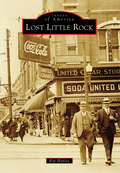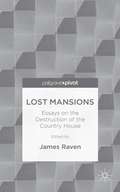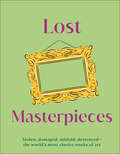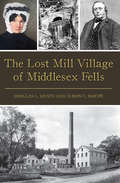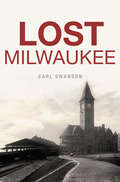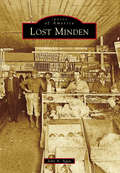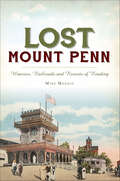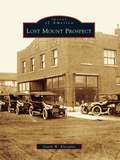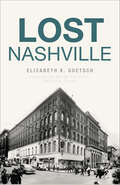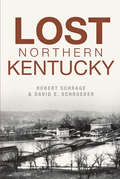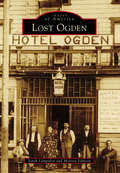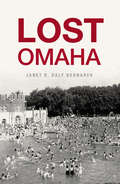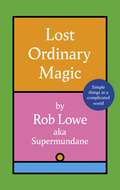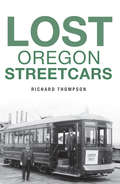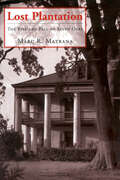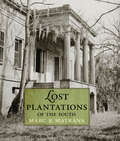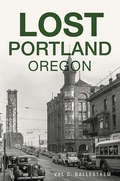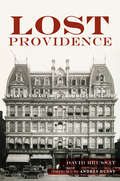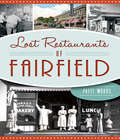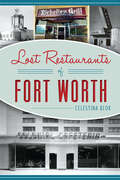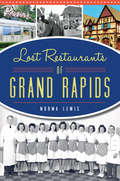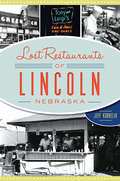- Table View
- List View
Lost Little Rock
by Ray HanleyLittle Rock is a sprawling city of about 200,000 at the center of a metropolitan area of more than 500,000 people, with many residing in bedroom communities in adjoining counties. Arkansas's capital city is much like the rest of Middle America with its outlying suburbs, gated communities, and shopping centers miles from the historic core. A century ago, however, Little Rock was markedly different and served a population of fewer than 50,000. The majority of citizens lived within blocks of the town center and did business downtown along rows of shops that, in many cases, dated to the late 1800s. Images of America: Lost Little Rock uses vintage photographs to reflect upon earlier times and the rich retail landscape that once filled the town. By exploring the legacies of buildings that have since been demolished, repurposed, or destroyed by fire, these images provide a sense of Little Rock's lesser-known heritage.
Lost Mansions: Essays on the Destruction of the Country House
by James RavenThis provocative volume stimulates debate about lost 'heritage' by examining the history of the hundreds of great houses demolished in Britain and Ireland in the twentieth century. Seven lively essays debate our understanding of what is meant by loss and how it relates to popular conceptions of the great house.
Lost Masterpieces: The World's Forgotten Masterpieces, from Stolen to Destroyed
by DKDiscover the extraordinary stories behind the world&’s missing works of art.Travel back in time to discover works of art that have vanished from the record, as well as those that went missing and have since been reclaimed or recovered. From the treasures of Tutankhamun to the altarpiece of Ghent, a missing Fabergé egg, and Vincent van Gogh&’s majestic Sunset at Montmajour, numerous masterpieces have disappeared throughout history as a result of theft, looting, natural catastrophe, or conflict… And some have resurfaced decades or even centuries later!Lost Masterpieces examines the unique story of the most significant of these artworks, the artists who created them, and those thought to be involved in their loss. It explores the various means by which museum curators and international crime investigators have unearthed missing treasures. It highlights the moral dilemma of museums that have profited from looted works of art and examines the recent &“heists&” made by some nations in an effort to regain their nation&’s stolen works of art.This awe-inspiring art history book promises:- A selection of the most important &“lost&” cultural artifacts from ancient times to the present day- Features images of the artworks where available, or specially commissioned illustrations of them based on written accounts-Includes details of the ongoing debate about whether looted art should be returned to its country of originDelve into the mysteries of ancient Egyptian tombs, marvel at the hoards unearthed by archaeologists, and discover the skulduggery behind the disappearance of priceless Rembrandts and Vermeers, and see the world of art and antiquities in a whole new light! A must-have volume for adults and young adults with an interest in art, culture and history, whether you&’re an art or history student, a collector of art antiques, or you&’re simply a curious lifelong learner, Lost Masterpieces is sure to delight.
Lost Metairie (Lost)
by Catherine CampanellaFrom ancient bayous to beloved old businesses, Metairie has changed dramatically over generations. And many of those landmarks are lost to time. The lake, railroads and a beach resort were popular features in the early days. A streetcar ran through the short-lived City of Metairie Ridge, where gambling houses and dog tracks contributed more tax dollars than did the few residents. Old Bucktown was famous for its seafood. Fat City, once notorious for its nightlife, has seen better days. Author Catherine Campanella takes a look back at the schools, shops, bars, restaurants, alligator farms, bowling alleys, drive-ins and movie theaters from a bygone era.
Lost Mill Village of Middlesex Fells, The (Brief History)
by Alison C. Simcox Douglas L. HeathOne of the earliest mill communities in the Massachusetts Bay Colony formed along Spot Pond Brook, a few miles north of Boston. Thomas Coytmore built the first mill in 1640 at the brook’s downstream end in “Mistick Side” (present-day Malden). Other mills sprang up along the brook as well. Today, most of Spot Pond Brook is hidden in culverts beneath the busy streets of Malden and Melrose. However, remnants of the lost mill village of Haywardville—foundations, millruns and ponds and waterfalls—are preserved within Middlesex Fells Reservation, part of Boston’s world-famous Metropolitan Park System. Authors Douglas L. Heath and Alison C. Simcox trace the history of this thriving early American community.
Lost Milwaukee (Lost)
by Carl SwansonFrom City Hall to the Pabst Theater, reminders of the past are part of the fabric of Milwaukee. Yet many historic treasures have been lost to time. An overgrown stretch of the Milwaukee River was once a famous beer garden. Blocks of homes and apartments replaced the Wonderland Amusement Park. A quiet bike path now stretches where some of fastest trains in the world previously thundered. Today's Estabrook Park was a vast mining operation, and Marquette University covers the old fairgrounds where Abraham Lincoln spoke. Author Carl Swanson recounts these stories and other tales of bygone days.
Lost Minden (Images of America)
by John A. AganMinden has transformed quite a bit since Charles Vedeer founded it in 1835. The town has suffered damages of the Civil War and Reconstruction and between 1872 and 1933 the devastation of five fires and a killer tornado. Despite disaster, Minden continues to progress, but adaptation and rebuilding have caused many familiar landmarks to vanish from the local landscape. The 1902 fire led to the enactment of a city ordinance banning wooden structures downtown; as a result, many edifices were reconstructed. Today, not a single building in the business district predates the 1870s, and the roles of those still standing--such as the First National Bank, which is expected to reopen as a restaurant--are continually changing. In 1918, another fire destroyed the Minden Lumber Mill, the town's largest industry. Later in the 20th century, the development of a city government complex demolished an entire shopping district, the 1905 Webster Parish Courthouse, and Minden City Hall. Lost Minden captures catastrophes, celebrations, storefronts, and back streets that otherwise only remain in memories. ?John Agan is a lifelong Minden resident who has been actively involved in local history writing and research for more than 30 years. In the course of these activities, he accumulated most of the vintage photographs in this volume that depict the Minden that has since been "lost."
Lost Minnesota: Stories of Vanished Places
by Jack El-HaiBelieve it or not, Minnesota&’s architectural landscape has included a house made from the fuselage of a B-29 bomber, a hotel that spent its final years as a chicken hatchery, a Civil War cemetery, a treehouse built and occupied year-round by an eccentric university professor, and a railway that once carried passengers up Duluth&’s steep incline from Lake Superior. They are all gone now, along with countless houses, parks, bridges, theaters, sports stadiums, courthouses, and farm buildings in which Minnesotans have worked, played, and lived their lives. Though other books have looked at the lost architecture of Minneapolis and St. Paul, Jack El-Hai&’s Lost Minnesota is the first book to tell the stories of buildings and landmarks from rural and small-town Minnesota, as well as those of the residential and suburban areas of the state&’s largest cities. From Rochester&’s Hotel Zumbro and the Charles H. Mayo House to the Hastings Spiral Bridge and the Lyceum Theater of Duluth, El-Hai rediscovers a lost landscape and the values and lifestyle of a bygone era. He tours not only Twin Cities buildings, such as the Fairoaks mansion, the Wilder Baths, and the Beyrer Brewery, but also its sites, such as the Wonderland amusement park, in order to re-create not only where but how Minnesotans lived. Lost Minnesota presents eighty-nine beautifully illustrated stories about these fascinating places and those who built them, lived in them, and tore them down. This is a book sure to delight the Minnesota history enthusiast and anyone who is curious about the state&’s changing urban, small-town, and rural landscapes.
Lost Mount Penn: Wineries, Railroads and Resorts of Reading (Lost)
by Mike MadaioGerman immigrants of the nineteenth century brought their traditions of winemaking and mouthwatering cuisine to the slopes of Mount Penn high above Reading.With a Santa Claus beard and a long-stemmed pipe, the hermit of Mount Penn, Louis Kuechler, founded Kuechler's Roost, where travelers flocked for feasts, literary soirees and free-flowing local wine. The opening of the Mount Penn Gravity Railroad brought a flurry of tourists from around the nation and fueled the creation of resorts throughout the countryside. Spuhler's Hotel hosted renowned pig roasts from noon until midnight. The fresh waters of Lauterbach Springs attracted wine and outdoor enthusiasts alike. Author Mike Madaio explores the vibrant society and culinary culture that made Mount Penn one of the best-known resort regions in the country until financial difficulties and the passage of Prohibition spelled its end.
Lost Mount Prospect (Images of America)
by Gavin W. KleespiesMount Prospect dates back to the 1840s. The village has a fascinating legacy as an immigrant community, an ambitious small town, an early progressive suburb, and a classic postwar community. However, few of today's residents are aware of this legacy. Much of Mount Prospect's past has been overshadowed by the incredibly rapid development of the past half century. The population of Mount Prospect in 1950 was around 4,000 people, the population was almost 19,000 by 1960, and today it approaches 60,000. This amazingly rapid development fundamentally changed how Mount Prospect saw itself and redefined the community's landscape. Many of the older buildings were demolished to make way for new developments or were modernized and are now hard to identify. The farms and early industries were replaced with houses and shopping areas. By the time this rapid development was over, it was hard to see what had been here before. Lost Mount Prospect is an examination of this history. It is a look at the village through the lens of what no longer exists.
Lost Nashville (Lost)
by Elizabeth K. GoetschNashville is chock-full of music landmarks, but there are quite a few historic structures that have been lost to time. The elegant Maxwell House Hotel served a breakfast blend that grew into the nationally known coffee brand. Public transportation first arrived in Nashville by way of horse-pulled streetcars in the 1860s. Fort Negley was the largest stone fort built during the Civil War. The Nashville Female Academy once served as the largest school for young ladies in the United States during the nineteenth century. Author Elizabeth Goetsch digs into the archives for some of the Music City's lost structures.
Lost Northern Kentucky (Lost)
by Robert Schrage David E. SchroederNorthern Kentucky has a unique location as the gateway between the North and the South. Many of its historic businesses, religious structures, homes and buildings were lost to time. Just after the Civil War, Daniel Henry Holmes purchased a large Victorian-Gothic house he named Holmesdale, better known as Holmes Castle. By the 1890s, the Latonia Racetrack had two hundred stables to accommodate horses and space for one hundred bookmakers. The Motordrome at the Ludlow Lagoon Amusement Park had seating for eight thousand people. Authors Robert Schrage and David Schroeder detail the fascinating history of Northern Kentucky's lost treasures.
Lost Ogden
by Sarah Langsdon Melissa JohnsonFrom a fur-trapping fort to a thriving metropolitan community, change has always been a part of Ogden's history. Settled in 1850 by Mormon pioneers, Ogden was forever transformed by the arrival of the transcontinental railroad in 1869. As horse-drawn carriages gave way to motor cars, a busy downtown district grew up around Ogden's Union Station and notorious Twenty-fifth Street. Landmark businesses, such as J.G. Read & Brothers Company and the Broom Hotel, became a part of the city's unique identity. Also unique to the city were its celebrations and special events, like parades, musicals, and sporting competitions. While change has always come to Ogden, the memories remain.
Lost Omaha (Lost)
by Janet R. BednarekThe landmarks of Omaha's past reveal a history of industry, innovation and change. The Hotel Fontenelle, the Omaha Athletic Club and the Medical Arts Building disappeared in the wake of changes remaking downtown after World War II. Jobbers Canyon, a vital part of the city's wholesale district, was sacrificed to ConAgra's headquarters. Peony Park closed as suburban sprawl prevented its expansion, and changing leisure patterns took residents farther away for their amusement park experience. The stockyards finally closed in 1999, ending a long chapter in Omaha's history. Author and historian Janet R. Daly Bednarek charts the legacy of Omaha's lost history through its landmarks.
Lost Ordinary Magic: Simple things in a complicated world
by Rob LoweLost Ordinary Magic is a book about simple things (such as: being alone, nonsense, pockets and spontaneity) told through personal stories, and observations, that are universal. The forced complexity of modern life means we are so busy dealing with a constant babble of advertising, news and social media, that it can be easy to forget that life can be simple and, often, the things that connect us and bring us joy are simple too.This book is a chance to take a break from our chaotic world and reconnect with the Lost Ordinary Magic all around us.
Lost Ordinary Magic: Simple things in a complicated world
by Rob LoweLost Ordinary Magic is a book about simple things (such as: being alone, nonsense, pockets and spontaneity) told through personal stories, and observations, that are universal. The forced complexity of modern life means we are so busy dealing with a constant babble of advertising, news and social media, that it can be easy to forget that life can be simple and, often, the things that connect us and bring us joy are simple too.This book is a chance to take a break from our chaotic world and reconnect with the Lost Ordinary Magic all around us.
Lost Oregon Streetcars
by Richard ThompsonThe streetcars that plied Oregon’s small-town streets were every bit as diverse as those in Portland and their history even more fascinating. Learn of the devastating 1922 fire that scorched Astoria’s plank road railways and put a halt to its once-thriving streetcar network. Muse over the tale of a beloved white horse named Old Charlie that proved more efficient at powering Albany’s streetcars than the alternative steam locomotive. Laugh at the spectacle of university students being carted back to their dormitories on the Eleventh Street Line’s special midnight “drunk express” trains. Take pride in the tiny town of Cherry Grove, which became the first in the West to embrace new battery technology. Local historian Richard Thompson celebrates the lost trolley lines that transported Oregon’s people across the state for decades.
Lost Plantation: The Rise and Fall of Seven Oaks
by Marc R. MatranaAlong the fertile banks of the Mississippi River across from New Orleans, planter Camille Zeringue transformed a mediocre colonial plantation into a thriving gem of antebellum sugar production, complete with a columned mansion known as Seven Oaks. Under the moss-strewn oaks, the privileged master nurtured his own family, but enslaved many others. Excelling at agriculture, business, an ambitious canal enterprise, and local politics, Zeringue ascended to the very pinnacle of southern society. But his empire soon came crashing down. After the ravages of the Civil War and a nasty battle with a railroad company, the family eventually lost the great estate. Seven Oaks ultimately ended up in the hands of distant railroad executives whose only desire was to rid themselves of this heap of history. Lost Plantation: The Rise and Fall of Seven Oaks tells both of Zeringue's climb to the top and of his legacy's eventual ruin. Preservationists and community members abhorred the railroad's indifferent attitude, and the question of the plantation mansion's fate fueled years of fiery, political battles. These hard-fought confrontations ended in 1977 when the exasperated railroad executives sent bulldozers through the decaying house. By analyzing one failed effort, Lost Plantation provides insight into the complex workings of American historical preservation efforts as a whole, while illustrating how southerners deal with their multifaceted past. The rise and fall of Seven Oaks is much more than just a local tragedy—it is a glaring example of how any community can be robbed of its history. Now, as parishes around New Orleans recognize the great aesthetic and monetary value of restoring plantation homes and attracting tourism, Jefferson Parish mourns a manor lost.
Lost Plantations of the South
by Marc R. MatranaThe great majority of the South's plantation homes have been destroyed over time, and many have long been forgotten. In Lost Plantations of the South, Marc R. Matrana weaves together photographs, diaries and letters, architectural renderings, and other rare documents to tell the story of sixty of these vanquished estates and the people who once called them home. From plantations that were destroyed by natural disaster such as Alabama's Forks of Cypress, to those that were intentionally demolished such as Seven Oaks in Louisiana and Mount Brilliant in Kentucky, Matrana resurrects these lost mansions. Including plantations throughout the South as well as border states, Matrana carefully tracks the histories of each from the earliest days of construction to the often-contentious struggles to preserve these irreplaceable historic treasures. Lost Plantations of the South explores the root causes of demise and provides understanding and insight on how lessons learned in these sad losses can help prevent future preservation crises. Capturing the voices of masters and mistresses alongside those of slaves, and featuring more than one hundred elegant archival illustrations, this book explores the powerful and complex histories of these cardinal homes across the South.
Lost Portland, Oregon (Lost)
by Val C. BallestremAs Portland has grown and changed, so has its architectural landscape. Once prominent landmarks have disappeared--the Marquam Building collapsed during 1912 renovations, the massive chamber of commerce building became a parking lot and the Corbett Building became a shopping mall. The city skyline was shaped by architects like Justus F. Krumbein and David L. Williams, only to drastically change in the face of urban renewal and the desire for modernization. Discover the stories behind some of Portland's most iconic buildings, including the Beth Israel Synagogue and the first East Side High School, both lost to fire. Join historian Val C. Ballestrem as he explores the city's architectural heritage from the 1890s to the present, as well as the creative forces behind it.
Lost Providence (Lost)
by Andres Duany David BrussatProvidence has one of the nation�s most intact historic downtowns and is one of America�s most beautiful cities. The history of architectural change in the city is one of lost buildings, urban renewal plans and challenges to preservation. The Narragansett Hotel, a lost city icon, hosted many famous guests and was demolished in 1960. The American classical renaissance expressed itself in the Providence National Bank, tragically demolished in 2005. Urban renewal plans such as the Downtown Providence plan and the College Hill plan threatened the city in the mid-twentieth century. Providence eventually embraced its heritage through plans like the River Relocation Project that revitalized the city�s waterfront and the Downcity Plan that revitalized its downtown. Author David Brussat chronicles the trials and triumphs of Providence�s urban development.
Lost Restaurants of Fairfield (American Palate)
by Patti WoodsThe culinary history of Fairfield, Connecticut, brims with bygone and beloved eateries and watering holes. Discover some of these lost classics, from the Sun Tavern--where George Washington enjoyed a few victuals--to the Scenario, where local celebrities always had a seat reserved at the bar. The best doughnuts in town were at the corner of Post and Beaumont at Devore's, while Art Green served up his famous chocolate cream pies at the Pie Plate. Join author Patti Woods for a generous serving of nostalgia complete with nachos from Sidetrack's, chili from Kuhn's and maybe even an ice cold beer from the Driftwood.
Lost Restaurants of Forth Worth (American Palate)
by Celestina BlokDespite a thriving culinary scene, Fort Worth lost some of its most iconic restaurants decades ago. Locals still buzz about the legendary chili dished out at historic Richelieu Grill and the potato soup Sammy's served all night. Fort Worth could accommodate every palate, from the Bakon Burger at Carlson's Drive-Inn to the escargot and chateaubriand laid out at the Carriage House. Even movie stars like Bob Hope and Gene Autry frequented the city for steaks from the Seibold Café, and President Lyndon B. Johnson loved Cowtown for the barbecue from famed chuckwagon cook Walter Jetton. Join food writer Celestina Blok as she journeys through her hometown's dining past.
Lost Restaurants of Grand Rapids (American Palate)
by Norma LewisGrand Rapids restaurants have served up meals and memories since the city's earliest days. At Bentham's, one of the first downtown restaurants, customers without money to eat could trade an animal pelt for supper. John Sebaitis trained his German shepherd, Spooky, to serve beer to the patrons at his tavern. And a seventeen-year-old Gerald R. Ford worked part time as a server and dish washer at Bill's Place. Join Norma Lewis as she explores the history of Grand Rapids' most beloved eateries and the stories behind them.
